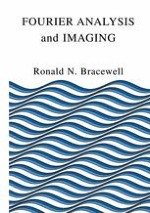2003 | OriginalPaper | Buchkapitel
Imaging by Convolution
verfasst von : Ronald Bracewell
Erschienen in: Fourier Analysis and Imaging
Verlag: Springer US
Enthalten in: Professional Book Archive
Aktivieren Sie unsere intelligente Suche, um passende Fachinhalte oder Patente zu finden.
Wählen Sie Textabschnitte aus um mit Künstlicher Intelligenz passenden Patente zu finden. powered by
Markieren Sie Textabschnitte, um KI-gestützt weitere passende Inhalte zu finden. powered by
Many images are constructed by active convolution arising from scanning motion. In others, even though motion is absent, the dependence of the image on the object can be expressed as a convolution integral, at least approximately. Examples of the former arise when the ground is scanned by the antenna of a microwave radiometer carried in an airplane or satellite for remote sensing purposes, when the sky is scanned by a radio telescope as in radio astronomy, or when a photographic transparency is scanned by passing light through a small orifice to a photodetector as in microdensitometry. When an object is photographed, pp the image is produced simultaneously rather than sequentially, but the intervention of the camera lens introduces degradation which also involves two-dimensional convolution. Image construction for the most part is linear, but even with linearity the convolution relation may be perturbed where there is partial failure of space invariance, as with lenses. Not uncommonly (as with overexposure or underexposure) there may also be some degree of nonlinearity. Both linearity and space invariance are prerequisites to the following discussion, which treats cases where there is a simple convolution relation between object and image. First we consider methods such as antenna scanning and photography, where the convolving function is a compact but fuzzy diffraction pattern, and then microdensitometry and other types of imaging, where the convolving function is more or less sharply bounded.
